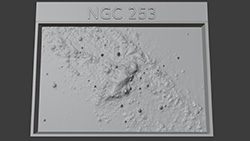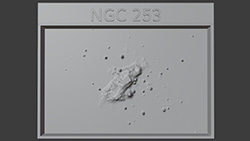CXC Home | Search | Help | Image Use Policy | Latest Images | Privacy | Accessibility | Glossary | Q&A
1
X-ray, H-alpha, Infrared & Optical Images of NGC 253Credit: X-ray: NASA/CXC/The Ohio State Univ/S. Lopez et al.; H-alpha and Optical: NSF/NOIRLab/AURA/KPNO/CTIO; Infrared: NASA/JPL-Caltech/Spitzer/D. Dale et al; Full Field Optical: ESO/La Silla Observatory.
Data from Chandra show the effects of powerful winds launched from the center of a nearby galaxy. An amount of hot gas equivalent to about two million Earth masses blows away from the galaxy’s center every year. These images of NGC 253 include Chandra data showing that these winds blow to the upper right and lower left. The images also show visible light data from Kitt Peak, emission from hydrogen, and infrared data from Spitzer. From Earth’s vantage point, NGC 253 appears nearly edge-on, seen in the wider-field optical image from the La Silla Observatory in Chile.
2
3D Printable Files: NGC 253 Composite(3D Print Credit: NASA/CXC/A. Jubett, using software by Tactile Universe/N. Bonne & C. Krawczyk & Blender)
This tactile plate depicts the central area of the spiral galaxy NGC 253 as a physical relief map based on the intensity of X-ray data captured by Chandra and infrared and optical data from other telescopes. The file for this plate can be downloaded and 3D-printed for learners to touch.
At the center of the spiral galaxy is a large blob. That is the galactic wind of extremely hot gas, detected by the Chandra X-ray Observatory. Surrounding the blob are mottled clouds and swirling structures from the infrared and optical light captured. In the image, hot winds are blowing in opposite directions away from the center of the galaxy. These powerful winds are spreading stellar material to the galaxy's next generation of stars and planets.
At the center of the spiral galaxy is a large blob. That is the galactic wind of extremely hot gas, detected by the Chandra X-ray Observatory. Surrounding the blob are mottled clouds and swirling structures from the infrared and optical light captured. In the image, hot winds are blowing in opposite directions away from the center of the galaxy. These powerful winds are spreading stellar material to the galaxy's next generation of stars and planets.
3
3D Printable Files: NGC 253 X-ray Only(3D Print Credit: NASA/CXC/A. Jubett, using software by Tactile Universe/N. Bonne & C. Krawczyk & Blender)
Return to: Chandra Determines What Makes a Galaxy's Wind Blow (March 29, 2023)












